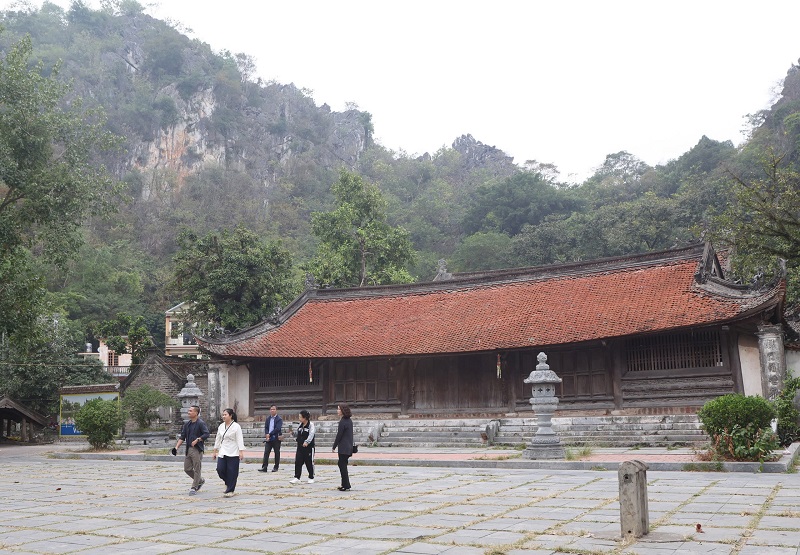
In front of the main shrine of Thay Pagoda. Photo: Thanh Hai/The Hanoi Times
Built in the mid-11th century, Thay Pagoda is not only an aesthetically pleasing structure but also a place deeply intertwined with the nation's history and spiritual traditions.
Associated with the legendary Zen master Tu Dao Hanh, the pagoda is situated on a tranquil river surrounded by lush green mountains. Its architecture reflects the sophistication and grandeur of its time. The sculptures and murals preserved within the pagoda are not only symbols of traditional artistry, but also reflect the rich and diverse history of the region.
In front of Thay Pagoda is a large courtyard overlooking Long Tri Lake. An old pavilion in the middle of the lake is often compared to a glittering jewel in a mythological dragon's mouth. During festivals, this pavilion is used as a stage for water puppet shows.
From the courtyard, two tile-roofed bridges - Nhat Tien Kieu and Nguyet Tien Kieu - extend to the sides, resembling a dragon's whiskers, adding to the pagoda's solemn and ancient ambiance.
Beyond its architectural beauty, Thay Pagoda is a place where Buddhists and visitors from home and abroad come to pray for peace, seek tranquility, and experience the sacred essence of spirituality. Because of its historical and cultural significance, Thay Pagoda was declared a National Intangible Cultural Heritage by the government in 2023.
Ngo Le Truyen from Hai Ba Trung District and Pham Quang Thanh from Hoan Kiem District said it was their first visit to Thay Pagoda. Both expressed their admiration for its ancient architecture, picturesque scenery and serene atmosphere.
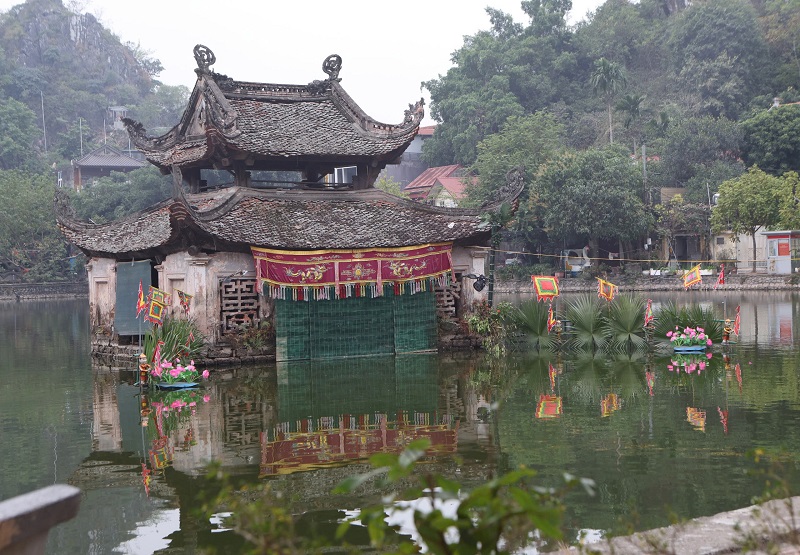
The Water Pavilion at Thay Pagoda, where water puppet shows are performed. Photo: Thanh Hai/The Hanoi Times
"This is a place where visitors like me or young people can come to find a sense of peace," Truyen told.
Meanwhile, first-time visitors to Vietnam, Romain Boucher and Lisa François, chose Thay Pagoda as one of their first destinations.
"I feel very calm in the pagoda and amazed by its architecture, which blends so harmoniously with the surrounding rocky mountains," Lisa told.
Nguyen Thi Hue, a tour guide, described Thay Pagoda as a sacred site that is both spiritually and historically fascinating, especially with its 1,000-year-old original architecture still intact.
"The pagoda attracts many visitors, especially during the Thay Pagoda Festival from the first to the third lunar month, when most people come to pray for peace," she explained.
So Village Communal House: a cultural gem of the Western Region
In addition to Thay Pagoda, Quoc Oai District is also home to another local cultural gem, So Village Communal House, located in Cong Hoa Commune.
This is one of the largest and most beautiful communal houses in the region, bearing deep historical and cultural significance.
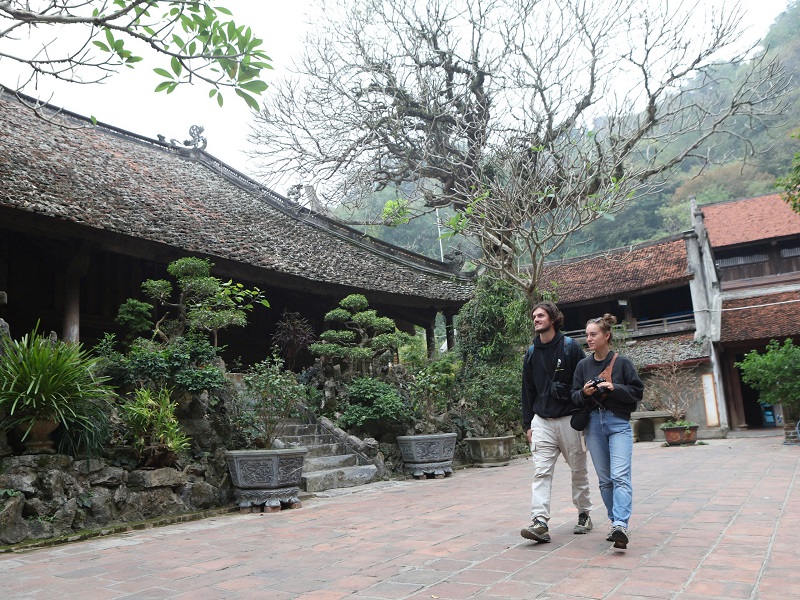
Foreign tourists at Thay Pagoda. Photo: Thanh Hai/The Hanoi Times
It was originally a small temple built during the Dinh Dynasty (968-980) to honor three generals who helped Emperor Dinh Tien Hoang quell the rebellion of 12 warlords and unify the kingdom.
In 1673, during the Le Trung Hung period (1533-1788), the shrine was renovated and expanded into a communal house, and the construction was completed in 1674. In March 2020, So Village's communal house was declared a special national relic.
The communal house faces the Day River and is surrounded by Turtle Mountain, making it a beautiful place to visit. With 18 stone steps leading down to a crescent-shaped pond, its tam quan (three-arched entrance) gate is considered a work of art and exudes a sense of solemnity and grandeur.
The intricate and diverse decorations, together with the sophisticated design, contribute to the uniqueness of this structure. With 55 compartments and 64 columns of all sizes, the So Village Communal House covers an area of 1,100 square meters and is designed in the "noi cong ngoai quoc" style, symbolizing the harmony between solidity and openness. The internal structures form a cohesive, fortified core, while the external components create an expansive, protective perimeter. This type of architecture demonstrates the meticulous attention to detail and ingenuity of the designers.
Although it has undergone four renovations and survived the upheavals of history, the communal house retains its harmonious blend with nature while embodying the essence of ancient Vietnamese communal houses.
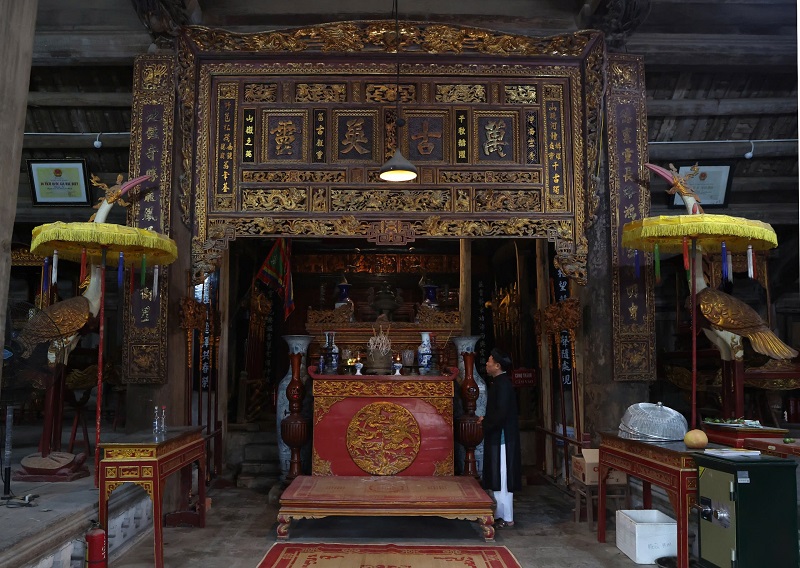
Inside the main shrine of the So Village Communal House. Photo: Thanh Hai/The Hanoi Times
The site also preserves valuable artifacts, such as two stone steles detailing the construction and restoration of the site, lotus-shaped column bases in the main hall, intricately carved stone dragons, and a meticulously crafted eight-pole palanquin. It also houses wooden, bronze, and textile relics, all of which have been carefully meticulously maintained.
The annual So Village Festival is held in the second lunar month and offers visitors a chance to experience not only the ancient architecture, but also the cultural soul embedded in every detail and scene of the site.
“We are very proud of this 400-year-old communal house in Xu Doai (the western region of ancient Thang Long), which has been preserved in its original state and contains 40 royal decrees, along with many ancient inscriptions and couplets," Nguyen Huu Minh, head of the So Village Communal House Elders Association, told.
"This is a convergence of spiritual and cultural values, a testament to our patriotic tradition, and a source of pride for the local community," he added.
The timelessness of both the Thay Pagoda and the So Village Communal House continues to attract visitors to Quoc Oai District, serving as a bridge between people and history, between the present and the past.
Preserving and promoting the values of these heritage sites is not only the duty of the local community, but the responsibility of society as a whole, to ensure that future generations can continue to explore and appreciate the country's rich cultural heritage.
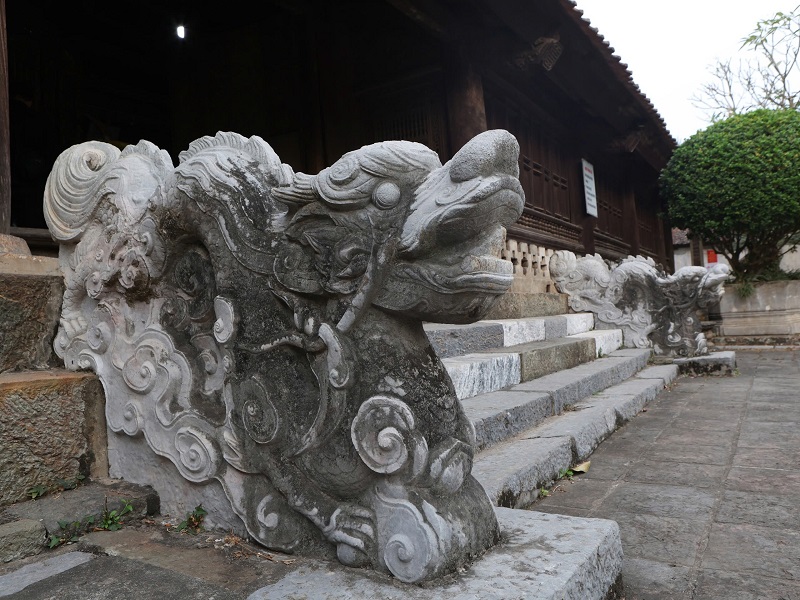
The communal house is famous for preserving its ancient architectural design after hundreds of years. Photo: Thanh Hai/The Hanoi Times
These two landmarks are not only unique architectural masterpieces, but also profound cultural symbols that shape the lives and thoughts of the local community.
Their enduring presence leaves a deep imprint on the cultural and spiritual landscape and contributes significantly to the preservation and promotion of Vietnam's traditional cultural values.
Huy Anh